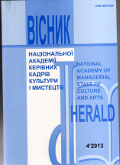Parameters of the new world: premodernism—modernism—postmodernism
DOI:
https://doi.org/10.32461/2226-3209.4.2013.138015Keywords:
premodern, modern, postmodern, modernism, postmodernism, folk cultureAbstract
The article is devoted to the transformation processes in the modern Ukrainian cultural field. Analysis showed that the modern Ukrainian socio-cultural field is heterogeneous. Axiological systems of premodern, modern and postmodern co-exist in the same cultural space, which is manifested in various semantic orientations of socio-cultural thinking of different layers of Ukrainian society. A significant part of Ukrainian society is on the stage of modern. Its mental-worldview matrix is based on atheistic model understanding the world and a linear interpretation of determinism, on temporal logic and logo-centrism, on the presumption of constructing a rational model of the world and the subject-object binarism. Postmodernism reflects a completely different way of understanding the world. Reflecting the worldview a certain layer of Ukrainian society, it orients on the model of the vision of reality that is based on a linear determinism. Postmodernism focuses on immanent logic of the self-development of unstable systems, as well as on multi-vector dynamic processes, refusing to the forced causality and logo-centrism. It was noted that today the paradigm of plurality of cultural development has methodological landmark in the study of a wide range of issues related, in particular, with the dynamics of local and plural phenomena in Ukrainian sociocultural space and the overcoming of inter-regional and inter-religious conflicts. However, postmodernism has not acquired the status of a philosophical tradition in the mode of past perfect. Its meaning and terminology tools are in the process of formation and not have sufficient unification. It is shown that at the same time paradigmatic orientation to the national traditions is preserved in the agricultural sector of Ukrainian society. This culture was formed a result of interaction everyday forms of activity and religious practices of the Ukrainian people. Ukrainian mentality is most often seen in the socio-psychological orientations of this segment of the population. People are perceived the basic aspects of the real and transcendental worlds it is through the mental matrix. The proven for centuries cyclical model of time is the most understandable to the everyday consciousness of Ukrainians with their agrarian way of life. And meanwhile, being dominant in a given society, the cyclic model is now coexists peacefully with the modernistic concept of socio-cultural development. It is proved that religion and religious institutions play an important role in traditional culture. Now religious ideas are actively being squeezed the Marxist-Leninist doctrine and atheistic ideology of the Soviet period. Most of the Ukrainian society sees in religion internal reserve for the stabilization of public life. However, this process takes place against the background of substantial transformation of the religious consciousness of the society, which is caused not only worldwide tendencies but also local features. Basic channel of retransmission of religious knowledge from the older generation to the younger was closed during the Soviet period. It has defined specific of modern Ukrainian religious consciousness. The gradual transition of religious consciousness from the dogmatic sphere in the ritual sphere was observed throughout the XX century. As a result the knowledge of religious observance has become more important than their theological meaning. The man was unable to define a clear life position in this interweaving of worldview paradigms and pluralistic axiology. This situation provoked an identity crisis in the Ukrainian society and actualized the problem of creating a strategy for the socialization of the individual in modern society.Downloads
Published
Issue
Section
License
Authors who publish with this journal agree to the following terms:
1. Authors retain copyright and grant the journal right of first publication with the work simultaneously licensed under a Creative Commons Attribution License International CC-BY that allows others to share the work with an acknowledgement of the work's authorship and initial publication in this journal.
2. Authors are able to enter into separate, additional contractual arrangements for the non-exclusive distribution of the journal's published version of the work (e.g., post it to an institutional repository or publish it in a book), with an acknowledgement of its initial publication in this journal.
3. Authors are permitted and encouraged to post their work online (e.g., in institutional repositories or on their website) prior to and during the submission process, as it can lead to productive exchanges, as well as earlier and greater citation of published work (See The Effect of Open Access).


